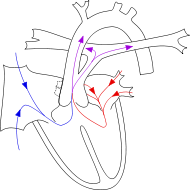- Persistent truncus arteriosus
-
Persistent Truncus Arteriosus Classification and external resources 
Diagrams to illustrate the transformation of the bulbus cordis. Ao. Truncus arteriosus. Au. Atrium. B. Bulbus cordis. RV. Right ventricle. LV. Left ventricle. P. Pulmonary artery.ICD-10 Q20.0 ICD-9 745.0 OMIM 217095 DiseasesDB 32081 MedlinePlus 001111 eMedicine ped/2316 MeSH D014339 Persistent truncus arteriosus (or Truncus arteriosus), also known as Common arterial trunk, is a rare form of congenital heart disease that presents at birth. In this condition, the embryological structure known as the truncus arteriosus fails to properly divide into the pulmonary trunk and aorta.
Contents
Classification
The most well-known classification was the fourfold system developed by Collett and Edwards in 1949.[1] Collett/Edwards Types I, II, and III are distinguished by the branching pattern of the pulmonary arteries:[2][3]
- Type I: truncus -> one pulmonary artery -> two lateral pulmonary arteries
- Type II: truncus -> two posterior/posterolateral pulmonary arteries
- Type III: truncus -> two lateral pulmonary arteries
The "Type IV" proposed in 1949 is no longer considered a form of PTA by most modern sources.[3]
Another well-known classification was defined by Van Praaghs in 1965.[3][4]
Causes
Most of the time, this defect occurs spontaneously. Genetic disorders, and teratogens (viruses, metabolic imbalance, and industrial or pharmacological agents) have been associated as possible causes. Up to 50% (varies in studies) of cases are associated with chromosome 22q11 deletions (DiGeorge Syndrome). The neural crest, specifically a population known as the cardiac neural crest, directly contributes to the aorticopulmonary septum.[5][6]
Microablation of the cardiac neural crest in developing chick embryos and genetic anomalies affecting this population of cells in rodents results in persistent truncus arteriosus.[7][8][9]
Numerous perturbations affecting the cardiac neural crest have been associated with persistent truncus arteriosus, some of which include growth factors (fibroblast growth factor 8 and bone morphogenetic protein), transcription factors (T-box, Pax, Nkx2-5, GATA-6, and Forkhead), and gap junction proteins (Connexin). The cardiac neural crest also contributes the smooth muscle of the great arteries.
Anatomical changes
Anatomical changes associated with this disorder includes:
- single artery arising from the two ventricles which gives rise to both the aortic and pulmonary vessels
- abnormal truncal valve
- right sided aortic arch in about 30% of cases (not shown)
- large ventricular septal defect
- pulmonary hypertension
- complete mixing occurring at level of the great vessel
- right-to-left shunting of blood
Clinical manifestations
- Cyanosis presents at birth
- Heart failure may occur within weeks
- Systolic ejection murmur is heard at the left sternal border
- Widened pulse pressure
- Bounding arterial pulses
- Loud second heart sound
- Biventricular hypertrophy
- Cardiomegaly
- Increased pulmonary vascularity
- Hypocalcemia (if associated with DiGeorge syndrome)
Treatment
Treatment is with neonatal surgical repair.[10] The ventricular septal defect is closed with a patch. The pulmonary arteries are then detached from the common artery (truncus arteriosus) and connected to the right ventricle using a tube (a conduit or tunnel). There have been cases where the condition has not been diagnosed at birth and surgical intervention is not an option. A number of these cases have survived well into adulthood. [11]
References
- ^ Collett RW, Edwards JE: Persistent truncus arteriosus: a classification according to anatomic types. Surg Clin North Am 1949; 29: 1245-70.
- ^ "Persistent Truncus Arteriosus: Congenital Cardiovascular Anomalies: Merck Manual Professional". http://www.merck.com/mmpe/sec19/ch287/ch287k.html. Retrieved 2007-11-04.
- ^ a b c "eMedicine - Truncus Arteriosus : Article by Doff McElhinney, MD". http://www.emedicine.com/ped/topic2316.htm. Retrieved 2007-11-04.
- ^ Van Praagh R, Van Praagh S (1965). "The anatomy of common aorticopulmonary trunk (truncus arteriosus communis) and its embryologic implications. A study of 57 necropsy cases". Am. J. Cardiol. 16 (3): 406–25. doi:10.1016/0002-9149(65)90732-0. PMID 5828135.
- ^ Kirby ML, Gale TF, and Stewart DE. (1983). "Neural crest cells contribute to normal aorticopulmonary septation.". Science 220 (4061): 1059–61. doi:10.1126/science.6844926. PMID 6844926.
- ^ Jiang X, Rowitch DH, Soriano P, McMahon AP, Sucov HM.. (2000). "Fate of the mammalian cardiac neural crest...". Development (Cambridge, England) 127 (8): 1607–16. PMID 10725237.
- ^ Hutson MR, Kirby ML.. (2003). "Neural crest and cardiovascular development: a 20-year perspective.". Birth Defects Res C Embryo Today. 69 (1): 2–13. doi:10.1002/bdrc.10002. PMID 12768653.
- ^ Waller BR 3rd, McQuinn T, Phelps AL, Markwald RR, Lo CW, Thompson RP, Wessels A. (2000). "Conotruncal anomalies in the trisomy 16 mouse: an immunohistochemical analysis with emphasis on the involvement of the neural crest.". Anat. Rec. 260 (3): 279–93. doi:10.1002/1097-0185(20001101)260:3<279::AID-AR65>3.0.CO;2-2. PMID 11066038.
- ^ Franz T. (1989). "Persistent truncus arteriosus in the Splotch mutant mouse.". Anat. Embryol. (Berlin). 180 (5): 457–64. doi:10.1007/BF00305120. PMID 2619088.
- ^ Rodefeld M, Hanley F (2002). "Neonatal truncus arteriosus repair: surgical techniques and clinical management.". Semin Thorac Cardiovasc Surg Pediatr Card Surg Annu 5 (1): 212–7. doi:10.1053/pcsu.2002.31497. PMID 11994881.
- ^ http://sfx.lis.curtin.edu.au/sfx_local?sid=Entrez%3APubMed&id=pmid%3A15872317
External links
- Pediatric Heart Surgery
- The Congenital Heart Surgery Video Project
- Truncus Arteriosus Repair in a Premature Newborn Baby
- Surgery for Truncus Arteriosus: Powerpoint™ Presentation
- Truncus Arteriosus Cincinnati Children's Medical Center
- Truncus Arteriosus information from Seattle Children's Hospital Heart Center
- 00755 at CHORUS
- Diagram at kumc.edu
- Overview at University of Michigan
Congenital heart defects (Q20–Q24, 745–746) Cardiac shunt/
heart septal defectAortopulmonary septal defectR→L: Double outlet right ventricle (Taussig–Bing syndrome) · Transposition of the great vessels (dextro, levo) · Persistent truncus arteriosusL→R: Sinus venosus atrial septal defect · Lutembacher's syndromeL→R and R→L: Eisenmenger's syndromeR→L, with other conditions: Tetralogy of FallotL→R: Ostium primumValvular heart disease/
heart chambersRightpulmonary valves (stenosis, insufficiency) · tricuspid valves (stenosis, atresia, Ebstein's anomaly) · Hypoplastic right heart syndrome (Uhl anomaly)LeftOther Dextrocardia · Levocardia · Cor triatriatum · Crisscross heart · Brugada syndrome · Coronary artery anomaly · Anomalous aortic origin of a coronary artery · Ventricular inversionCategories:- Congenital heart disease
- Rare diseases
Wikimedia Foundation. 2010.

